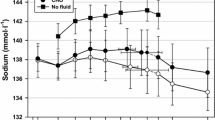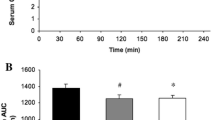Summary
Seven healthy male subjects exercised to exhaustion at a workload equivalent to 100% of their maximal oxygen uptake (\(\dot V_{O_{2\max } }\)) on 3 separate occasions. Each high intensity exercise test was performed on an electrically braked cycle ergometer; the first took place after a normal diet (46±8% carbohydrate (CHO), 41±7% fat and 13±3% protein); the second after 3 days of a low CHO diet (7±3% CHO, 64±5% fat and 29±4% protein) and the third after 3 days of a high CHO diet (76±6% CHO, 14±5% fat and 10±2% protein). Acid-base status and selected metabolites were measured on arterialised venous blood at rest prior to exercise and during the post-exercise period. Plasma urea concentration and urine total acidity were measured on each day of the experiment. Exercise time to exhaustion was longer after the normal (p<0.05) and high (p<0.01) CHO diets compared with the low CHO diet. Pre-exercise plasma bicarbonate concentration and blood \({\text{P}}_{{\text{CO}}_{\text{2}} }\) were higher after the high CHO diet when compared with the normal (p=0.05, p<0.05 respectively) and low CHO conditions (p<0.05, p<0.05 respectively). Pre-exercise bicarbonate was also higher after the normal CHO diet when compared with the low CHO diet (p<0.05). Mean dietary acid intake for each 3 day period of dietary variation and plasma urea immediately prior to exercise were lower after the high CHO diet when compared to both normal (p<0.01, p<0.01) and low (p<0.01, p<0.001) CHO diets. They were also lower (p<0.01, p<0.01) after the normal when compared with the low CHO diet. Urine total acidity was higher after the low CHO diet when compared with both the normal (p<0.01) and high CHO (p<0.01) diets and near significance was found (p<0.06) when comparing the normal and high CHO diets. The present exsuggests that dietary variation alone can significantly affect the acid-base balance of the blood and may thereby influence endurance time during high intensity exercise.
Similar content being viewed by others
References
Asmussen E, Klausen K, Egelund Nielsen L, Techow OSA, Tonder PJ (1974) Lactate production and anaerobic work capacity after prolonged exercise. Acta Physiol Scand 90:731–742
Bergstrom J, Hermansen L, Hultman E, Saltin B (1967) Diet, muscle glycogen and physical performance. Acta Physiol Scand 71:140–150
Boobis LH, Maughan RJ (1983) A simple one step fluorimetric method for determination of glycerol in 20 μl of plasma. Clin Chim Acta 132:173–179
Camien MN, Simmons DH, Gonick HC (1969) A critical reappraisal of ‘acid-base’ balance. Am J Clin Nutr 22:786–793
Forster HV, Dempsey JA, Thomson J, Vidruk E, DoPico GA (1972) Estimation of arterial \({\text{P}}_{{\text{O}}_{\text{2}} }\), \({\text{P}}_{{\text{CO}}_{\text{2}} }\), pH and lactate from arterialised venous blood. J Appl Physiol 32:134–137
Greenhaff PL, Gleeson M, Maughan RJ (1987) The effects of dietary manipulation on blood acid-base status and the performance of high intensity exercise. Eur J Appl Physiol 56:331–337
Guthrie HA (1983) Introductory Nutrition. (5th Edition) CV Mosby Company London, pp 118–127
Hermansen L (1981) Muscle fatigue during maximal exercise of short duration. Medicine Sport 13:45–52
Hirche HJ, Hombach V, Longohr HD, Wacker U, Busse J (1975) Lactic acid permeation rate in working gastrocnemii of dogs during metabolic alkalosis and acidosis. Pflügers Arch 356:209–222
Hultman E, Bergstrom J (1967) Muscle glycogen synthesis in relation to diet studied in normal subjects. Acta Med Scand 182:109–117
Hultman E, Del-Canale S, Sjoholm H (1985) Effect of induced metabolic acidosis on intracellular pH, buffer capacity and contraction force in human skeletal muscle. Clin Sci 65:505–510
Jacobs I (1981) Lactate, muscle glycogen and exercise performance in man. Acta Physiol Scand [Suppl 495] 1–35
Jansson E (1982) On the significance of the respiratory exchange ratio after different diets during exercise in man. Acta Physiol Scand 114:103–110
Jansson E, Kaijser L (1982) Effect of diet on the utilisation of blood-borne intramuscular substrates during exercise in man. Acta Physiol Scand 115:19–30
Jorgensen (1957) Titrimetric determination of the net excretion of acid-base in urine. Scand J Clin Lab Invest 9:287–291
Karlsson J (1971) Lactate in working muscle after prolonged exercise. Acta Physiol Scand 82:123–130
Karlsson J, Saltin B (1970) Lactate, ATP and CP in working muscles during exhaustive exercise in man. J Appl Physiol 29:598–602
McCance RA, Widdowson ED (1960) The composition of foods. MRC Special Report Series No. 297. London HMSO
Mainwood GW, Worsley-Brown P (1975) The effects of extracellular pH and buffer concentration on the efflux of lactate from frog sartorius muscle. J Physiol 250:1–22
Maughan RJ (1982) A simple, rapid method for the determination of glucose, lactate, pyruvate, alanine, 3-hydroxybutyrate and acetoacetate in a single 20 μl blood sample. Clin Chim Acta 122:231–240
Maughan RJ, Poole DC (1981) The effects of a glycogen-loading regimen on the capacity to perform anaerobic exercise. Eur J Appl Physiol 46:211–219
Noma A, Okabe H, Kita M (1973) A new colorimetric microdetermination of free fatty acids in serum. Clin Chim Acta 43:317–320
Randell HT (1966) Water, electrolytes and acid-base balance. In: The Foundations of Nutrition (Eds CM Taylor and O Florence) Macmillan New York. Ch 8 pp 355–394
Saltin B, Hermansen L (1967) Glycogen stores and prolonged severe exercise. Symposia of the Swedish Nutrition Foundation V, Blix G (ed), pp 32–46
Saltin B, Karlsson J (1971) Muscle glycogen utilisation during work of different intensities. In: Muscle metabolism during exercise (Eds B Pernow and B Saltin) Plenum Press, New York, pp 289–300
Shohl AT (1923) Mineral metabolism in relation to acid-base equilibrium. Physiol Rev 3:502–543
Siggaard-Andersen O (1963) Blood acid-base alignment nomogram. Scand J Clin Lab Invest 15:211–217
Siggaard-Andersen O (1974) The acid-base status of the blood (4th edition) Munksgaard Copenhagen
Sutton JR, Jones NL, Toews CJ (1981) Effects of pH on muscle glycolysis during exercise. Clin Sci 61:331–338
Author information
Authors and Affiliations
Rights and permissions
About this article
Cite this article
Greenhaff, P.L., Gleeson, M., Whiting, P.H. et al. Dietary composition and acid-base status: limiting factors in the performance of maximal exercise in man?. Europ. J. Appl. Physiol. 56, 444–450 (1987). https://doi.org/10.1007/BF00417773
Accepted:
Issue Date:
DOI: https://doi.org/10.1007/BF00417773




